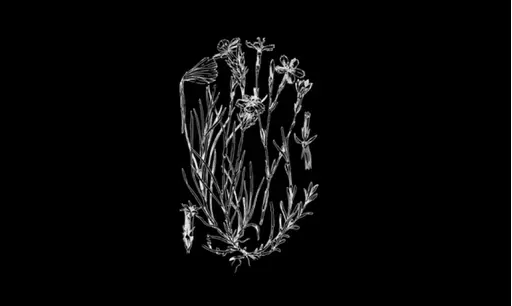
Author(s)
Pelşîn Tolhildan
“We are in the siege of a nature that has been hurt, divided, defiled, poisoned, harmed, and made to bleed,” writes Pelşîn Tolhildan, member of the Kurdish Women’s Movement.
It suggests that the increasing climatic disasters affecting humans are, as Tolhidan says, “illustrative of nature’s mysterious self-defense power.” Pushing back at the sci-fi imaginations which project some kind of seed-carrying space-colonizer, the text foregrounds a need to engage with present catastrophes in a material sense and highlights how damage done to the earth disproportionately affects those bearing the brunt of colonial capitalist modes of governance and ownership. Republished here in the context of Prospections’ focus around artist Marwa Arsanios’s Usufructuaries of earth project, Tolhildan’s text aligns with the concept of usufruct—forming a non-exploitative relationship of “use” with the earth—and is written within the framework of Jineology—a feminist ideology around radical coexistence with nature. Straddling the line between a prophecy and history, Tolhildan’s text is a fierce call for people to consider their responsibilities, consciousness, and actions in relation to climate urgencies.
Tolhildan appears as a speaker in Arsanios’s film Who Is Afraid of Ideology? Part 1 (2017), and was an interlocutor for Who Is Afraid of Ideology? Part 2 (2019), which are exhibited at BAK, basis voor actuele kunst, Utrecht as part of Usufructuaries of earth, running until 2 June, 2024.
Every phenomenon whose value we do not appreciate makes us pay the price. The bigger the value that we do not recognize, the bigger the price we pay for betraying it. If it is our own nature whose value we do not appreciate, the nature into which we are born, this price will turn into global warming and burn us, it will become a forest fire and roast us, it will become a flood and drown us, it will turn into ice and freeze us, it will become contamination and poison us. And for every day that we ignore nature’s calls to solve the problem, death will hits us even harder. But has it always been the case that we do not recognize the importance of nature? Is this how we developed? How could we become the enemies and killers of the oceans, forests, lands, and air that have given birth to us? And how could the same nature, which is our birth nest, turn into fire raining down on us, into flood, and into poison that throws up on us? Life is still in nature’s hands, just like death. But when and why did nature start proving to its own children, who kill life, its own ability to kill? Does nature have a mind that makes fun of our mind which considers itself as the supreme one among “God’s highest creations”? Our soul creates disasters when being hurt and it is a part that comes from this nature—so perhaps, when we hurt this nature’s soul, it takes revenge by destroying! But why? And how? These are now questions that no human who lives on this world can escape from any longer. Understanding where, when, and how this harm and the resulting process of having to pay the price for it have begun, must be the responsibility of every human who wants to live in freedom. So in order to understand the issue, let’s start at the roots. Let us have a look at what kind of mentality we have lost and how it related to nature:
“Natural society’s mentality world relies on an animated understanding of nature. It believes that every phenomenon in nature has a spirit. Spirits are understood as features that secure aliveness. In the totemic religions the concept of an external, ruling deity apart from the self is not yet developed. Great effort is made to be in harmony with nature’s spirits. Failure to do so is similar to death. When this is the fundamental perspective on nature, an extraordinary need for harmony emerges. According to the most fundamental principle of ecology, we are face to face with life. Effort is made to avoid societal life from going against the natural forces. When constructing religions and ethics, the most fundamental principle is the harmony with the environment and the natural forces. This principle is so deeply rooted in the mentality that it is valued as a religious and moral tradition. In fact, this is the principle of life’s natural flow manifesting itself in the human society. There is no being that does not consider its environment. Short-term deviations are overcome in a stream within external and internal conditions; otherwise, by being completely left out of the system, they cease their existence. The importance of the principle of ecology for human society derives from this fundamental feature of nature.
In natural society, all members of the sociality organically participate in the entirety of life. Everyone is a genuine, essential part of society. Belief and perceptions are common. The concepts of lying and cheating have not yet developed. It is as though they speak the same childish language with nature. To dominate nature, to abuse it, is the biggest sin, a taboo, evil, and against their ethics and beliefs, their newly developed societal rules. What was turned upside down in the slave-holding statist society is this religious and ethical fundamental principle.”
However, humanity increasingly lost touch with this ethical understanding:
If we take a look at internet searches related to thousands of recent news items on “environment” or “ecology,” while keeping in mind that such searches can only scratch the surface of the real extent of our earth’s ecological disaster, it is easy to hear this outcry: dams and other infrastructures that swallow natural beauties; nuclear plants; fossil fuel energy sources; forest fires due to wars or climate change; petrol contamination of water and soil; chemical waste dumping; deforestation; intoxication of soil, water, and air due to gold cyanidation; the global food crisis and the development of GMOs; the dangerous disposal of medication; lack of access to clean drinking water; greenhouse gases related to industrial agriculture; extinction of species; mined territories; earthquakes; activated volcanoes; tsunamis; the emergence of illnesses; the disappearance of natural environments in favor of cities and factories; acid rain; and perhaps many other phenomena we may not even be aware of and which have caused ecological disasters by human hand. Extending this list not only depresses us, the multiple dimensions of the problem are also illustrative of nature’s mysterious self-defense power.
Nature has an evolutionary character that has been in action for millions of years. This is not about the fittest exterminating the less fit. Perhaps it is true that the less fit decrease in numbers. However, the smallest organisms to the great ecosystems in nature arrange, adapt, and change themselves according to changing conditions. In other words, nature resists. It creates its own mechanisms to defend itself, or the human-caused issues upset nature’s balance and result in catastrophes that bring about great changes. While humans tried to conquer and dominate nature and engage in a competition to show nature who is the master, they forgot a fairly simple phenomenon: nature was their home, their birth nest, it was the life atmosphere to which humans owe their bread, water, their very existence, and happiness. “The fundamental reason for ecological problems is the ruling power rendering an anti-natural life possible through its tyranny and lies. By denying nature’s role in life and by replacing it with fake deities and creators, it is possible to call nature ‘blind force’.” 4 But the eyes and hearts that were so focused on profit ambitions remained oblivious to this naked reality. While the belief was held that nature has been made mute after all these attacks, the one who was forced on their knees in the end was the human. Nature managed to express itself in many ways, while it was the humans forced to swallow their tongues. In order to see the ways in which we pay the price for destroying nature’s right to live—the same nature we owe our life to—let us have a brief look at some natural disaster news from the time when this article was first written (2009–2010):
Experts claim that the flood in Pakistan and the extreme heat in Russia are linked to the extraordinary impacts of global warming. Due to flood and landslides, more than 700 people in China, more than 1,600 people in Pakistan, and more than 130 people in India have been killed. Thousands of people disappeared. Millions of people lost their homes. In the smog and dust that covers Moscow and which resulted in drought, toxic material has been discovered. In the fires that have started in more than 600 different areas, 50 people in Russia have been killed. The fires started to affect the military areas so that the explosive materials in these regions were carried to other areas by the authorities. In Chile, 1.5 million homes were destroyed, the number of disappeared people rose to 300. Chile’s president Bachelet claimed that he could not find the words to describe the 8.8 level earthquake and the catastrophe it caused. In a country with a population of 16 million, at least 2 million were affected by the earthquake. Rescue attempts continue in Italy’s north, where an earthquake took the lives of 250 people. In the earthquake, fifteen thousand buildings were rendered inoperable. It has been reported that the bush fires that have been continuing in the south of Australia for days have been caused by arson. Fires continue still in 20 different places. The number of deaths might increase to 230. Global warming is melting the glaciers of Mount Kilimanjaro, which is considered a world heritage site. The forest fires in Greece cannot be brought under control. The fire that started near Athens is approaching the city center. Due to the increasing fire, strengthened by the wind, a state of emergency has been declared.
Things have only worsened ever since this 2009 to 2010 period. More recently, a scientific report by the World Wildlife Fund revealed that 60% of animal populations have been wiped out by humanity since 1970, with disastrous effects on nature and its human children. It seems that ecological catastrophe has advanced to such a degree that it would take up to 7 million years for nature to recover even if destruction would be halted now. Entire species are predicted to die out. Countless hurricanes, droughts, floods, wildfires, and melting glaciers are anticipated. Experts speak of a “climate genocide.” The most affected humans of these developments are in the Global South, in particular, indigeneous and rural communities, whose relationship to nature is symbiotic and organic. The ecological crisis is also caused by the global arms trade and, likewise, wars are often triggered by changes in the climate, due to unsustainable capitalist interests in natural resources. Yet, states and companies, the main culprits of ecological catastrophe, consciously withdraw from legal and international responsibilities and resort to means of denying the obvious, disastrously approaching death of life. As if to summon the end of the world, they announce further destruction of natural habitats and the exploitation of life. And there are more news items about bigger and smaller ecological disasters and catastrophes that are not include here.
Is it possible that humans call human-made catastrophes “natural disasters,” in order to cover up their own guilt? Or perhaps, by calling these disasters “God’s plan,” they try to find a divine partner in crime? In reality, no disaster is able to grow this much and claim so many lives, without the impact of humans. Indeed, human-made industry, technology, wars, weapons— biological or any other kind of weaponry—overpopulation, and many other developments or inventions burn nature, and nature burns back. The more it gets destroyed by human hands, it destroys back. The more it gets massacred by humans, it brings death to humanity.
These are neither expressions of a pessimistic point of view, nor do they reflect the propaganda of a science-fiction hero that is looking for a piece of land to start a new social life with the seeds in their hands after all the lands have been eradicated. Maybe these catastrophes may not have impacted all of us individually yet. Perhaps we have not yet seen hundreds of people die at once in front of our eyes. But everybody who lives on this planet needs to know that the human-made catastrophes are as close to us as are our breath, water, and bread—even as the blood running in our veins. As always, we are under nature’s siege. But this nature is no longer the natural nature of thousands of years ago. This nature is a nature whose nature has been manipulated. That is why its siege is unlike its mother nest. We are in the siege of a nature that has been hurt, divided, defiled, poisoned, harmed, and made to bleed. Of course, in cases when nature seemed defenseless against humans, there have been times where it brought disasters in turn. But what was the difference? The nature of that nature had not yet been played with. Through certain observations, humans were able to more or less identify and estimate the location, time, and extent of such disasters and act accordingly. But nowadays we are not even aware of how exactly we harm nature as humans. Who knows how many nuclear tests there are? How much have our seas, our lands been contaminated by petrol or toxic material? We don’t know exactly the amount of greenhouse gases and carbon contamination. Who would know the biodiversity and ecosystems that were eliminated by the soldier hands that also burned down the forests of Kurdistan? In short, there is an uncontrollable attack on nature by humans. That is why perhaps nature will strike back with a horrible surprise through a series of uncontrollable disasters that we cannot anticipate. Our aim is neither to demonize humans nor to advocate for a protection of nature that is separate from the human and society. We merely discuss a factual reality that was designed by human hand, mind, and action, perhaps due to lacking knowledge around the importance of time.
At the beginning of this writing, we mentioned the development of the ecological issue with the rise of the slave-holding system. But those concerned with ecological problems are aware that the system that has deepened and further led these issues toward unsustainability is capitalism. “Europe’s individualism has come to embody the massacre of the society and its ecology. The capitalist system’s establishment of its dominance, its move from individuality to individualism, not only reversed social gains, but also caused the biggest ecological deviation in history.” 5
Ecological issues and their sources have been discussed through a variety of philosophical, societal, eco-feminist, and many other perspectives, and have thus been made visible as a serious problem for years now. Perhaps the real problem then is how much this problem is being felt. This concerns the real powers of society. Because when the real forces that make up society start to sense this problem, a large part of the solution will have been achieved. Because “[t]he actual ecological phenomenon is to prevent the relationship between nature and society, to become a gap. If this gap is not closed as soon as possible, society will turn into dinosaurs.” 6 When we look at the issue from this perspective, we can make a global effort to sense the problem and bring it to the agenda.
The World Social Forum’s slogan “Another World is Possible”; the UN’s climate conferences; locally organized free ecological forums; social urban movements, the agreement of big countries on issues like reducing carbon intensity; countries’ discussions on bio-security; the creation of ecological collectives; hundreds of thousands of activists around the world risking their lives to draw attention to ecological issues; the discussions of eco-socialists and eco-feminists; the organization of ecology festivals; UNESCO compiling a list of endangered world heritage; sustainable energy conferences; the slogan “The dead don’t wear gold” of those whose soil has been contaminated; and thousands of actions, events, organizations, work increasing awareness and activism are all signs of an effort to close this gap between nature and society. However, when considering the size of the catastrophe we are facing, these initiatives remain dispersed and insufficient. Let us look at the call made by an ecology site: “The ecological crisis is not a coincidental feature of capitalism. It is in the DNA of the system. It is not possible to resolve through reforms this incessant hunger, the desire to multiply profits perpetually. The only thing that capitalists can think of when considering the ecological crisis is how much more profit they can make out of it. Therefore, the struggle against the ecological crisis cannot succeed until the capitalist system is removed.”
Indeed, the mentality of the solution is important. To create a common ecological mindset in the face of the capitalist, civilizationist mentality that created ecological destruction means to organize and mobilize all of these efforts and bring about a faster and more efficient intervention. Founding member of the Kurdistan Workers’ Party Abdullah Öcalan’s statement that “the revolution of the 21st century is ecological” not only stresses the extent of the solution but also its importance, as well as the idea that the crisis is indeed resolvable when the solutions are implemented. This statement is also important to understand and expose the cleverness of market circles and their views that the global ecological crisis can be resolved within capitalism or through reforms. When we look at the effects of the problem on our lives, even only roughly, it is clear that a revolutionary viewpoint and practice is necessary. In order to see this, the problem must be approached in an ethical way. Because if our real standard in our attitude toward nature is the natural society, and if natural society is the stem cell of the ethical-political society, our perspective on the resolution of ecological issues must contain an ethical dimension:
It is not possible to defend the rationality, ethics of any societal system that does not unify with nature. The reason for the system being overcome in terms of rationality and morality is the fact that it is in the greatest conflict with nature. The relationship between the chaos experienced by the capitalist societal system and environmental catastrophe is dialectical. Only the exit from the system can overcome the radical contradictions with nature. It is clear that environmental movements alone cannot overcome this contradictory character. On the other hand, an ecological society necessitates a moral transformation as well. The anti-ethical system of capitalism can only be overcome with an ecological attitude. The ethics-conscience relationship necessitates an empathetic and sympathetic spirituality. This in turn can only carry meaning with a competent ecological equipment. It is friendship with nature, it is the belief in natural religion. As such, it means to reunite with the natural organic society with a new and awakened consciousness. A societal consciousness devoid of an ecological consciousness cannot help but dissolve and corrupt, as seen in the case of real socialism. Ecological consciousness is fundamentally an ideological consciousness. It is like the bridge between the borders between philosophy and ethics. Only if the politics that aim to save us from the contemporary crisis are ecological, it can lead us toward a right societal system. 7
“No matter how small, there are the remains of natural society in everybody.” 8 Perhaps this means we need to look at our inner mirror when looking for solutions. Only if everybody turns toward this inner mirror to examine one’s own responsibilities, consciousness, and actions, ecological problems and nature’s mysterious extraordinary existence can be felt. With this in mind, we must not allow capitalism to propagate individualist solutions to what requires a global system change.
2 Öcalan, Bir Halkı Savunmak, p. 133.
3 Josephine Donovan, Feminist Theory: The Intellectual Traditions of American Feminism (New York: Frederick Ungar Publishing Company, 1985).
4 Öcalan, Bir Halkı Savunmak, p. 134.
5 Öcalan, Bir Halkı Savunmak, p. 95.
6 Abdullah Öcalan, Ideolojik Kimlik (Sosyal Bilimler Akademisi Yayınları, 2007), p.112.
7 Öcalan, Bir Halkı Savunmak, p. 136.
8 Imralı prison island notes.
Originally published 31 October 2018 on Komun Academy, republished with style adjustments under Creative Commons licensing,creativecommons.org
Related

Held in the context of Usufructuaries of earth: chapter two, reading groups and publication, a reading group was convened by Iliada Charalambous and Philippa Driest on 28 April 2024 titled Undoing Debt, at KIOSK, Rotterdam. The reading group looked at debt as a form of gendered and financial violence and sought how to, in turn, “undo debt” through learning shared political tools and vocabulary inspired by transnational feminist movements.
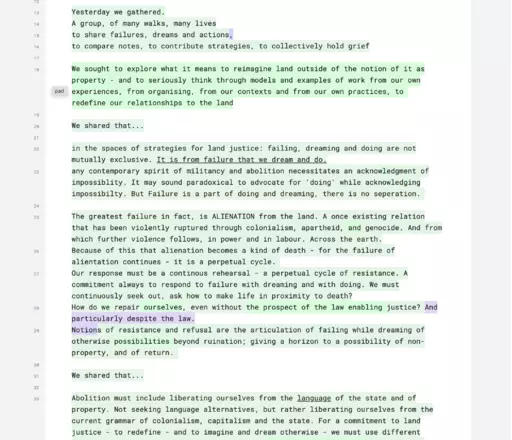
Convened by Johannesburg-based Yvonne Phyllis and MADEYOULOOK (Molemo Moiloa and Nare Mokgotho), the working session Failing, Dreaming, Doing: rehearsing abolition sought to conjure alternate imaginaries of life and labor with earth, beyond the regimes of colonial and racial enclosure. The following text was collectively written by the working session’s participants: Brenna Bhandar, Aya Bseiso, Layal Ftouni, Jennifer Irving, Tareq Khalaf, Gelare Khoshgozara, MADEYOULOOK (Molemo Moiloa and Nare Mokgotho), Marie Nour Hechaime, Yvonne Phyllis, Philip Rizk, Bobby Sayers, Shela Sheikh, and Kasia Wlaszczyk and was read out by Nare Mokgotho as part of “PROPOSITION 3 Failing, Dreaming, Doing: rehearsing abolition” during the Usufructuaries of earth convention public program, Saturday 25 May 2024 at BAK, basis voor actuele kunst, Utrecht.
________________________________________________________________________________
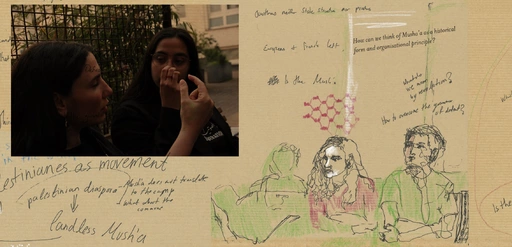
Held in the context of Usufructuaries of earth: Chapter two, reading groups and publication, a reading group spanning two days was convened by Joud Al-Tamimi and Lama El Khatib on 4 and 5 May 2024 titled And in your throats, a sliver of glass, a cactus thorn and On Value-Disrupting Activity, at bookstore خان الجنوب khan Aljanub, Berlin and Hopscotch Reading Room, Berlin respectively. Mokia Laisin put together a collaborative collage of annotations made during both days of the reading group discussions with input from Miriam Gatt on 4 May 2024.
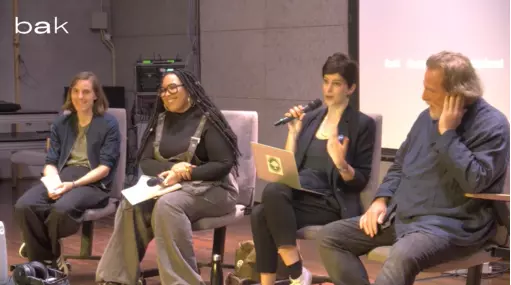
Held as part of day two of Usufructuaries of earth, chapter three, convention, on 25 May 2024, this video documents a closing conversation between Yvonne Phyllis, Denise Ferreira da Silva (online), Verónica Gago, Stefano Harney, Lena Wilderbach, and Brenna Bhandar (online), moderated by Shela Sheikh.
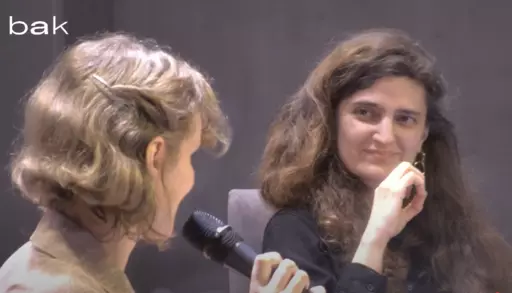
Held as part of day one of Usufructuaries of earth, chapter three, convention, on 24 May 2024, this video documents the words of welcome by Maria Hlavajova, followed by a conversation between Marwa Arsanios and Wietske Maas—as means of introduction to the Usufructuaries of earth public program.
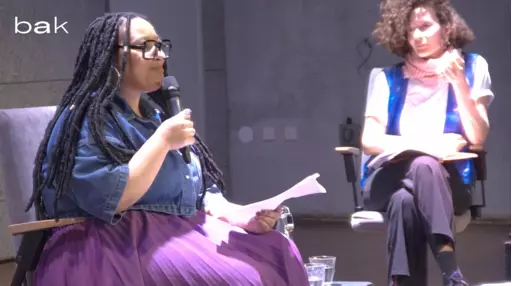
Held as part of day one of Usufructuaries of earth, chapter three, convention, on 24 May 2024, this video documents a conversation between Brenna Bhandar, Yvonne Phyllis, and Ruth Wilson Gilmore(online), moderated by Layal Ftouni.
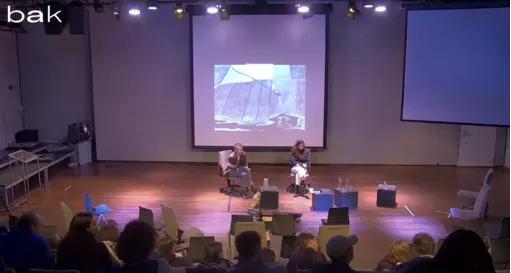
Held as part of day one of Usufructuaries of earth, chapter three, convention, on 24 May 2024, this video documents a conversation between conversation between Philip Rizk and Marwa Arsanios following a screening of Rizk’s film Mapping Lessons (2020).
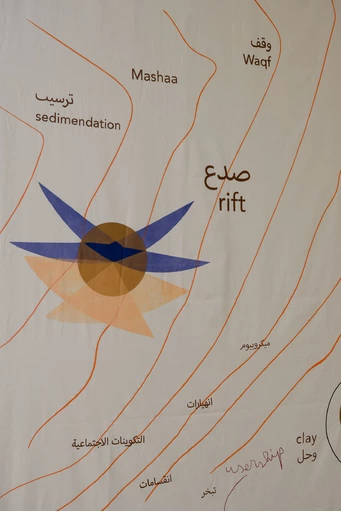
This essay, “Enclosures from Below: The Mushaa’ in Contemporary Palestine,” from geographer and researcher Noura Alkhalili is shared as part of the project Usufructuaries of earth, co-convened by BAK with artist Marwa Arsanios. It is one of the readings for the Amman reading group convened by artist-led research group Bahaleen involving locally-invited artists and researchers.
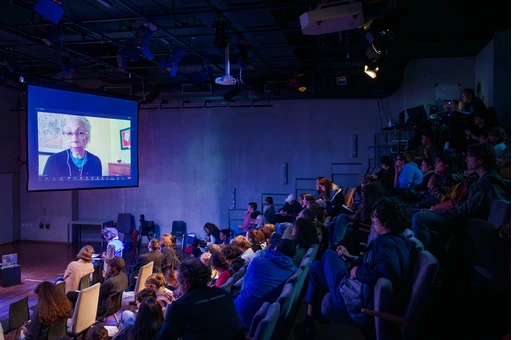
This chapter, “Scholar-Activists in the Mix,” from Ruth Wilson Gilmore's Abolition Geography: Essays Towards Liberation (2022) is shared as part of the project Usufructuaries of earth, co-convened by BAK with artist Marwa Arsanios. It is one of the readings for the Amman reading group convened by artist-led research group Bahaleen involving locally-invited artists and researchers.

This chapter, “Improvement,” from legal scholar Brenna Bhandar’s Colonial Lives of Property: Law, Land, and Racial Regimes of Ownership (2018) is one of the readings for the Amman reading group.
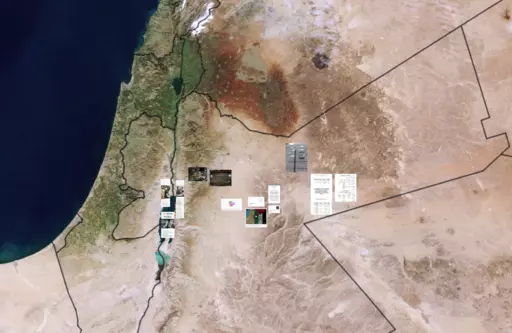
In the context of Usufructuaries of earth: Chapter two, reading groups and publication, a multi-day roaming reading residency, convened by the artist-led research group Bahaleen is held from May 9–13 2024, along the hilltops of Jerash and the edges of Palestine—an hour’s drive from Amman. Invited artists and researchers join Bahaleen in traveling by car and on foot, navigating notions of access and return. Together they grapple with the possibilities of disruption and dissent, aiming to articulate a liberatory vision of the commons from within this geopolitical conjuncture. During the reading residency a board of images and sources were assembled as a harvesting. The images are shared below as screengrabs from this image board, with accompanying links where appropriate.

Originally published in Otherwise Worlds: Against Settler Colonialism and Anti-Blackness (Duke University Press, 2020), this essay, "Reading the Dead: A Black Feminist Poethical Reading of Global Capital" by academic, philosopher, and artist Denise Ferreira da Silva is shared here in the context of the project Usufructuaries of earth, co-convened by BAK with artist Marwa Arsanios. This chapter is one of the readings for the Berlin reading group convened by Joud Al-Tamimi and Lama El-Khatib, titled “On Value-Disrupting Activity,” at Hopscotch reading room, 5 May 2024. This reading group explores the political and theoretical stakes of value as it links to violences enacted on and through land and property in Palestine and elsewhere.
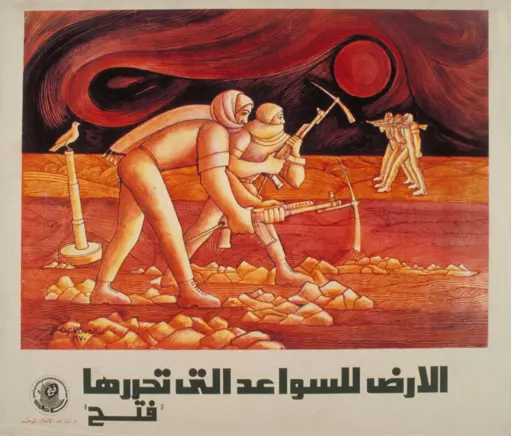
“What is a revolution that neither overthrows a state order nor institutes a lasting one of its own?” This is the question that teacher, author, and political theorist Nasser Abourahme poses in “Revolution after Revolution: The Commune as Line of Flight in Palestinian Anticolonialism.”

Three excerpts are republished here from researchers and activists Verónica Gago and Lucí Cavallero’s A Feminist Reading of Debt (London: Pluto Press, 2021). The text opens with a simple concept: that contemporary debt cannot be understood by only looking at “public debt,” and must instead look at the indebtedness present in everyday life. The authors call for debt to be adopted by social movements as a key issue, and furthermore, for people to be cognizant of the links between debt and sexist violence.
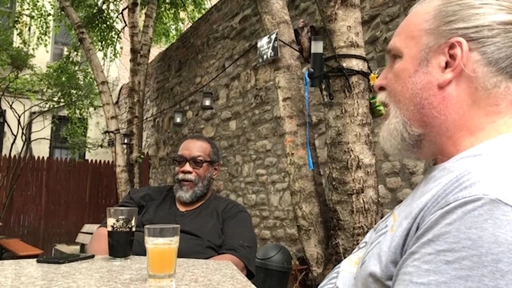
This is an extract from the chapter “Debt and Study,” in Stefano Harney and Fred Moten’s The Undercommons: Fugitive Planning & Black Study (2013). Across its three sections—Debt and Credit, Debt and Forgetting, and Debt and Refuge—this extract traces the sites and practices of “desired” and undesired debt that perforate contemporary financial capitalism and western culture. The text moves through different people who are marked as debt carriers, such as the precariat, the student, and racialized people, among others.
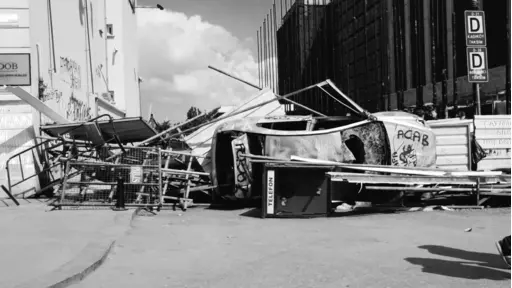
“Riot Now: Square, Street, Commune” is a chapter from political theorist Joshua Clover’s Riot. Strike. Riot: The New Era of Uprisings (Verso, 2016). Taking the classical Greek agora—a place of assembly and commerce—as a starting point, Clover suggests that it is perhaps no coincidence that many of the riots and occupations that emerged in recent decades either happened or began in modern squares. He speaks of how this emergence of rioters corresponded to “an underlying political-economic unity, a material reorganization of society, which provide[d] them a shared set of problems and a shared arena in which to confront them.”
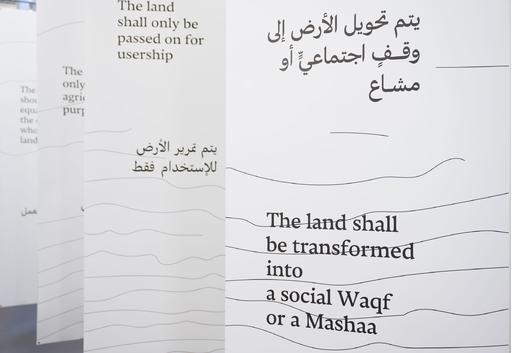
Charting the interconnectedness of capitalism, colonialism, and nationalism, Peter Linebaugh’s “Palestine & the Commons: Or, Marx & the Musha’a” speaks of “the violence of mapping, titling, buying, and selling which cast people into cities and camps following their expropriation from the land.”
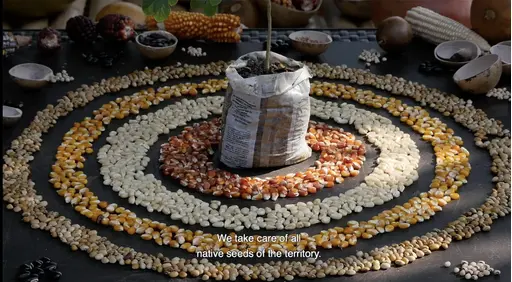
Originally published in Kohl Journal, this interview is between Samanta Arango Orozco, a member of Grupo Semillas, and the artist Marwa Arsanios, who is co-convening with BAK the multi-chaptered project Usufructuaries of earth until 2 June, 2024.
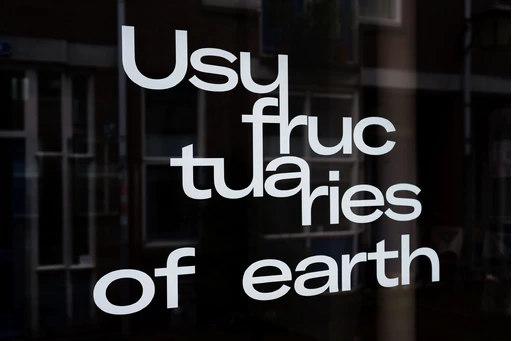
A slow-growing table of contents for the Usufructuaries of earth online reader. The reader emerges, to begin with, as a constellation of archival texts assembled here through the “Usufructuaries of earth” focus on Prospections. Throughout the duration of Usufructuaries of earth project and beyond, diverse content—long reads, interviews, conversations, and visual interventions—will incrementally be (re)published into a public research and learning curriculum that studies histories and propositions of usufruct, of renewing shared practices of usership of and with earth.

“We are in the siege of a nature that has been hurt, divided, defiled, poisoned, harmed, and made to bleed,” writes Pelşîn Tolhildan, member of the Kurdish Women’s Movement.

Usufructuaries of earth is the first comprehensive exhibition of Marwa Arsanios’s work in the Netherlands. The exhibition foregrounds the artist’s collaborative approach to bringing together ecological, feminist, and decolonial knowledges and practices that put forward ideologies of usufruct, unhinging property-relations from the idiom of individuated possession and toward forms of common, more-than-human userships. Here is an audio tour of the exhibition given by BAK convenor of research and publications Wietske Maas.